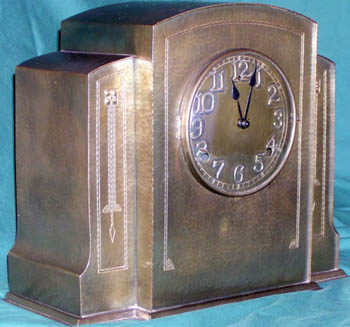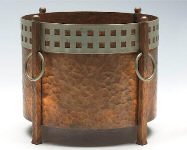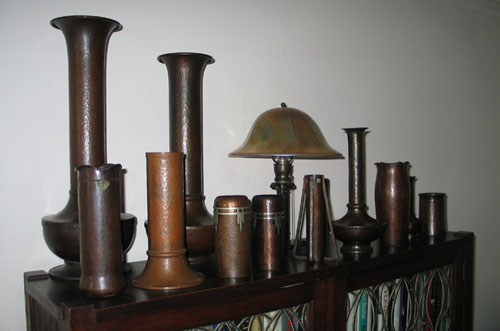
These items were acquired over the course of several years by a highly motivated collector. A key element in bringing them together was his willingness to jump quickly when the rare ones came up. He thought it would be fun to see what they looked like all displayed together -- it makes for a great picture! The Collector's Goal First off, let me say that I think Roycroft metalwork is currently undervalued. Consider that the BEST examples of the premier art potteries (Grueby, Rookwood, Marblehead, Newcomb, etc) are generally selling for over $50,000 a pop. And Gus furniture seems to be setting record prices at every auction, with fine Morris chairs over $25,000, "meat and potatos" bookcases over $10,000, and anything truly rare and special completely unaffordable by normal people. The fact that you can still pick up a Roycroft buttress vase for under $6,000 or a mint 19 inch American Beauty vase for under $4,000 tells me the Roycroft market has not yet fully matured. So despite the recent rise in Roycroft copper prices, you have to keep it all in perspective. I recognize that most Roycroft was a production line product, and unique pieces are few and far between, but they do exist, and very rare Kipp or Jennings pieces (real "art" objects) are still not far beyond the production prices. Another way to look at it is that I don't see why a nice Van Erp vase continues to cost two, three, or even five times the price of a nice Kipp or Jennings vase. As for collecting advice, I may be stating the obvious here, but new collectors should avoid gobbling up every $200 pair of bookends that passes by. The best collections have fewer but better objects. I don't know about you, but I'd rather have one Ford Shelby Cobra than a lot full of Pintos. Remember that better pieces appreciate in value quicker, are easier to sell, and are more enjoyable to own. So leave the bookends, ashtrays, crumb scrapers, and letter openers to the other guy, and go ahead, buy that $7,000 buttress vase! The photo below illustrates a small but exceptionally well-focused collection of Roycroft vases (and a bowl). For fun, just take out your calculator and add up the estimated market price of this little assemblage -- I'm thinking around $45,000!
If you're a new Roycroft collector or you're a seller unfamiliar with the nuances of what separates a great piece from an average one, it might help to know some of the things that experienced collectors look for when evaluating a Roycroft copper item. Objects must speak for themselves, and even the orb and cross mark will never turn a sow's ear into a silk purse. In that regard, below are some of the factors I feel are most important in affecting value. None of this is groundbreaking, and I may be adding this page simply because I'm tired of seeing stuff overpriced just because it's Roycroft.
Every Roycroft collector dreams of finding one-of-a-kind pieces like this clock Rarity Everyone really wants what nobody else has. Generally speaking, the rarer an item, the more desirable it is. That's why the prices of signed Kipp or Jennings stuff seem to have surpassed Roycroft prices lately. For example, there are fewer Kipp-signed glass bud vases than Roycroft ones so they're worth more, even though they're virtually identical except for the mark. Of course there are exceptions. Some late Roycroft copper items that are spun rather than hammered or have an acid-etched finish are actually quite rare. They didn't make much of some of this stuff, mostly because nobody was buying it at the time. But I wouldn't touch most of it because it doesn't meet any of the important criteria listed below.
Rare, early, beautiful, finely crafted, and functional items like this Karl Kipp box are particularly desirable and valuable Form What is it? A lamp, a vase, a box, or a cigar holder?It makes a big difference. Lamps, in addition to looking cool, are really useful, vases look great no matter where you plop them down and they look even better in a group, and boxes are the best places to stash your little Roycroft pins or whatever. But what the hell do you do with 3 cigar holders? Anything that's hard to display or just not very useful is going to be less desirable to a collector. After all, we like to show off our junk, and I have yet to figure out how to make a decorating statement with ashtrays (not to mention crumb scrapers!).
Beauty Sort of related to form, but different. I'm talking about aesthetic quality. For example, some Roycroft vases are really beautiful, like the German silver "bullet vase". I would own ten of them if I could afford it, because the design is just so right. But there are other vases that missed the mark a little design-wise, like, in my opinion, most of the glass insert stuff. Aesthetics is probably the easiest factor to overlook in the mad rush to acquire an object. In early 2001 a Roycroft teapot showed up on eBay. Although the piece didn't hit the reserve, the high bid was over $600. Although I think it scored high marks for rarity, and condition seemed good, it had to be one of the ugliest little things Roycroft ever made. Sometimes I like to imagine what someone unfamiliar with Roycroft copper would say about a piece if you set it on a table. If the answer might be "That's so beautiful!" then think about buying. If it's "Umm...it's...an old teapot", then resist the urge to splurge. You might find it interesting to know that the forms that I own that never fail to elicit "oohs and aahs" are my German silver bullet vases -- everybody loves them. The Beauty vases, on the other hand, get about a 50% approval rating..."They look like big metal bongs"... "Does a genie come out when you rub it?"...etc, etc.
Importance Somewhere out there a bunch of art historians are sitting around deciding which objects are "important". You remember them, in college they wore black and smoked clove cigarettes. Now they write books and advise museums on what to acquire. What does this have to do with Roycroft? Plenty, because the academics have identified Roycrofter Dard Hunter's travels to Europe in the early days of the twentieth century, and his subsequent use of certain avant garde European design elements, as a significant link between early Modernism in Europe and America. The result is that a few Roycroft designs, like Kipp's heavily Vienna Seccession-influenced jardiniere below, are "important" enough for the Metropolitan and other major museums to own. Needless to say, the imprimatur of the cognoscenti means high desirability and prices to us lowly collectors.
Here is a group of circa 1912-1915 Roycroft and Kipp pieces that demonstrate the Secessionist-influence on the earliest Roycroft work. Each of these forms is therefore important in the history of American design and highly desirable to collectors (click for a big version): Workmanship Generally speaking, things with tooled designs, made with heavier weight copper, with nice even hammering are worth more and are more desirable. These characteristics make an item objectively better than one that's plain, light weight and crudely hammered. Frequently the workmanship is better on earlier objects. For example, most early vases and bowls were hammered from heavy sheet copper over a form, the hammering was an intergral part of the item's manufacture, and these are substantial objects. Many later pieces, even those with nice tooled decorations, were spun on a lathe and then hammered just to provide "the look". They can sometimes feel flimsy even if they look OK. Know that most stuff signed with "Roycroft" along with the orb and cross mark is of lesser quality workmanship. I'm also a big fan of "workmanship per square inch". That's why I think the cylinder vases, including the 5 inch, 7 inch and 10 inch versions, are so great. A lot of hammering and chasing (tooling) went into those, and it shows. The little covered incense burners also have a lot going on (hammering, rivets, curls), and to me that makes them more desirable.
Condition Condition is extremely important to value, with mint condition examples often selling for two or three times the price of the same item with a cleaned finish or other damage. Condition becomes even more important with items that show up regularly, since collectors have the option of waiting for a better example to appear on the market. Date Earlier is generally better. All the German silver stuff, aside from the "bullet vase" was made before the late teens. The Italian Polychrome line was also done relatively early on (probably not made after the early 20's). The rest of the early stuff tends to be rarer and of higher quality than the late stuff too. It helps to have old catalogues to date stuff, but if you don't have them you can just look at the mark. So if you're wondering why a simple plain bowl or candlestick sells on ebay for a small fortune and your "nicer" one tanks at $200, chances are the expensive one was an early gem and yours is a common later form. Size I suppose you can say that when it comes to Roycroft copper, bigger is better. There are big vases and small ones, and all else being equal the big ones are typically worth more. This is true of most of the other stuff as well. Huge bowls and lamps can set record prices. The size factor is easy to see with things like American Beauty vases. They get more expensive as they get taller. However, other factors can throw a wrench into this rule. If your little 5 inch tooled vase has a KK mark on the bottom, it'll blow away a taller Roycroft vase. Just look at the Bookends page to see how valuable a tiny 4 inch pair of rare Kipp bookends can become when several different bidders decide they have to own them. Color One of the first things a collector might ask about a sight-unseen piece is "what color is it?". In other words, early brown, Italian Polychrome, Aurora Brown, Old Brass, Blue Brass, Silver, acid-etched, Etruscan, etc etc. Given a choice, most collectors want the brown stuff, so brown is generally better. Of course, some pieces only came in one color, like the Etruscan or Verde Green stuff, so if your piece is green don't panic. It may be that odd color for a reason, and if it also has brass decorations on it you can start planning your next vacation. However, some finishes will never be considered good. I have yet to see an acid-etched piece that I really like. Availability A minor factor, but something to keep in mind. And not to be confused with rarity. Sometimes when it rains it pours. You can go a year without seeing a mica panel lamp for sale and then three or four will show up at once. At that point you don't want to be the person trying to sell number five! The Roycroft market at the high end is probably not that big. After all, how many people are really willing to spend seven thousand dollars on a copper vase? So it's subject to variations in demand and supply. If you're looking to get the most out of your high-end Roycroft piece, try to sell during a drought. Check ebay and recent auction catalogues to see if what you have has sold lately. And if you're buying, it may be better to hold off on the first lamp or beauty vase to show up for a while. Trust me, there WILL be another one. Below are some fun collection pics:
|













